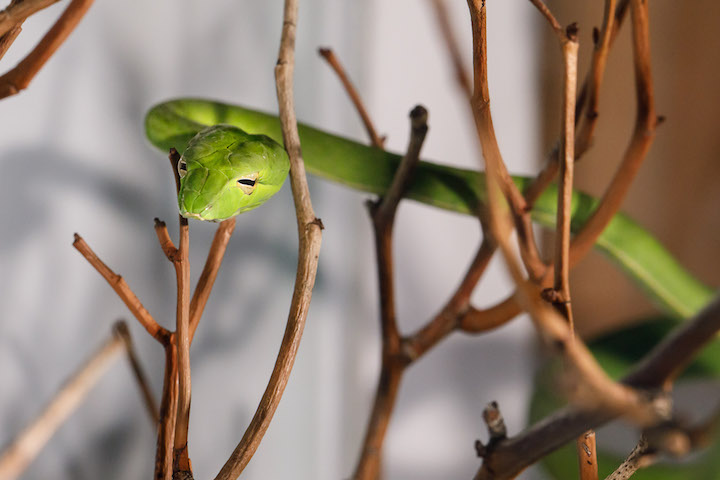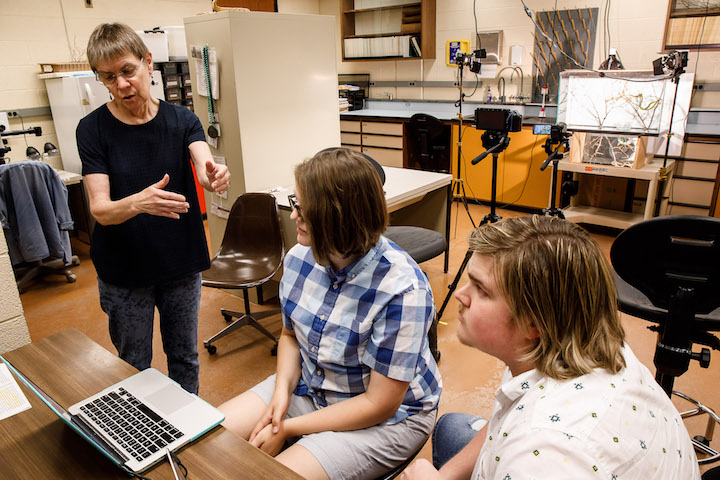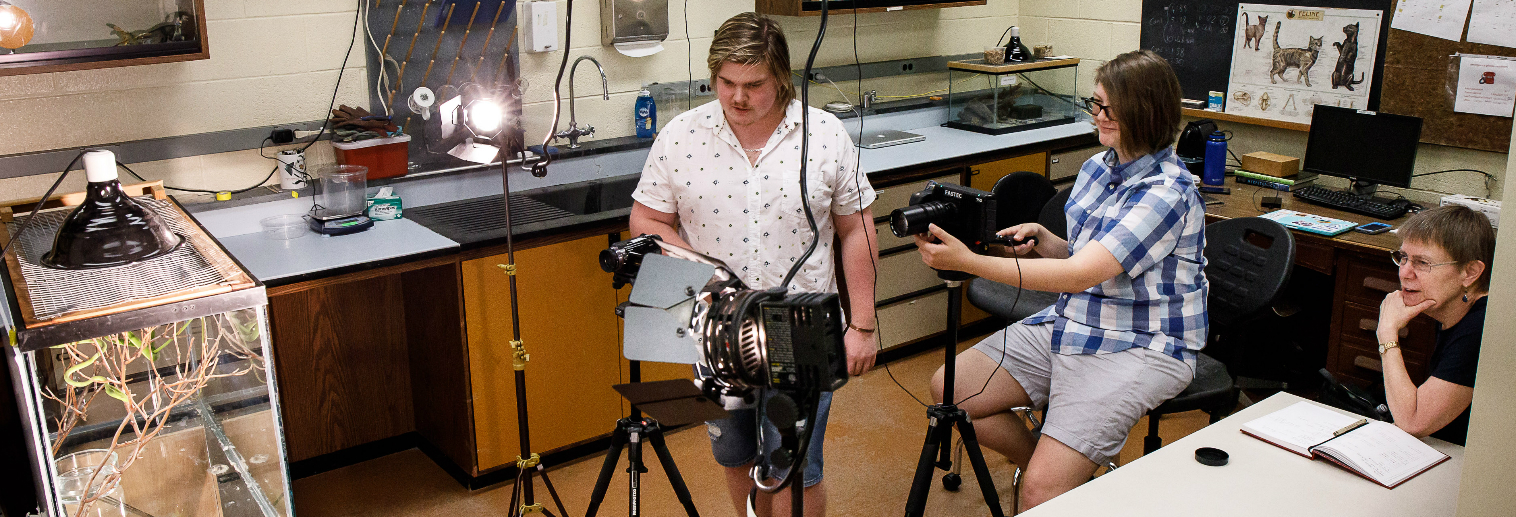Tevo’n Campbell ’21 & Emma Adam ’19
“Kinematic of Prey Handling in Arboreal Snakes”
Tevo’n Campbell ’21
Major: Undeclared
Hometown: Boksburg, South Africa
Emma Adam ’19
Major: Chemistry, pre-veterinary track
Hometown: Kutztown, PA
Project Advisor: Dr. Frances Irish
Describe your project.
TC: We analyzed the way in which the maxilla of the snake moves by measuring the snout to achieve the unilateral movements of eating prey items. This process comes from frames that were recorded. The aim is to determine the twist of the snout by looking at the rostral scale. The project included researching snakes and their feeding abilities, as well as understanding a snake’s ability to move their jaws unilaterally.
EA: During our SOAR research, we worked with snakes to determine their snout mobility and compare this mobility to past research with snakes in a different genus. Specifically, I worked with Ahaetulla prasina, Ahaetulla nasuta, and Chilabothrus striatus. To do so, we filmed the snakes feeding on lizards and mice and analyzed the footage frame by frame. For snout twisting, we are finding the rotation of the snout vs. the axis of the braincase.
How did your project come about?
TC: The idea has been an ongoing investigation that Dr. Irish has been working on for a number of years to determine how the snout twisting came about in snakes and where in the different abilities of snakes to move their snouts at different angles developed along the phylogenetic tree. These snakes are arboreal Colubroid snakes, which are considered to be advanced snakes in comparison to other snakes researched in the past by Dr. Irish.
EA: I had approached Dr. Irish about working with her for a SOAR project based on snake snout twisting, but this specific idea for the project came later as we were discussing the possibilities. Once Dr. Irish had obtained some snakes from the genus Ahaetulla I knew that I wanted to work with them over the summer and analyze the snout twisting aspect.

What was the best part about working with your faculty mentor? What valuable insights did she bring to your project?
TC: Dr. Irish was always willing to help and ensure that we understood all the finer details of the project to ensure that the outcome would be the best it could be. Dr. Irish also helped me to understand that doing research on a topic off of a scholarly website can be more frustrating and time consuming in comparison to a more general Internet search. She helped me to see that finer details, particularly in the scientific field, are necessary to achieve the best result. Dr. Irish is a very focused person when it comes to research and this translated to her dedication to the topic, which I found extremely encouraging and insightful to future endeavors.
EA: Dr. Irish brought a lot of knowledge and structure to the project. I loved being able to understand what she was researching in more detail as well as getting her expertise on the subject. She helped me to learn about snake feeding in detail, as well as gain a general anatomical basis for how snout twisting occurs. All in all, it was an honor to work with Dr. Irish this summer.
What was your biggest obstacle?
TC: My biggest obstacle was actually starting the project. I found it difficult to find information on the one snake I was tasked with researching and found it rather frustrating to find viable information. It took a longer more strenuous search to pull information from different sources and reading the reference pages of many articles to find the desired information from the original source. I had never been exposed to this extensive long line of research process during my freshman year and thus found it difficult.
EA: When working with the Ahaetulla prasina, there are some individuals that don’t eat as often or stalk the prey’s reflection rather than the prey itself. Since analyzing films is a huge part of our analysis, having the snakes not eat or miss a strike can cause a large obstacle. Other than this, getting the prey and snake to cooperate when positioning them in the right places can be extremely difficult, since we’re working with two live animals.
What has been your biggest takeaway from this experience?
TC: The program has shown me that researching is a long process, in some cases it takes years to find an answer. It showed me that dedication, commitment, and passion for your topic is what should drive a person when they set off to discover something. It has shown me that long hours and tireless attempts are a key factor to achieving the end goal.
EA: I’ve learned a lot more about snakes in general as well as the genus Ahaetulla, specifically. Throughout this experience, I’ve learned how I work individually as well as how to organize myself to reach my maximum capabilities. All in all, I’ve gained a large appreciation for an animal that many have a phobia of and an appreciation for their capabilities.
What was the result of your project?
TC: We have expanded on Dr. Irish’s previous work in showing that different snake species have different abilities in their snout rotation. This helped us to determine that the more advanced colubroid snakes may have developed their larger capability for snout twisting as a result of evolution. This led to us asking a question for further research of where this evolution occurs in the phylogenetic tree of snakes.
EA: We are still in the process of getting all our results for the project. However, for the preliminary results, I compared the genus Ahaetulla to Chilabothrus striatus, Eryx spp., and Boa constrictor. As we can see right now, the genus Ahaetulla has a large snout twisting ability. Chilabothrus striatus has some ecological similarities to genus Ahaetulla with being arboreal, but also has similar ecological factors to small burrowing boas (Eryx spp.), being a boa itself. The Chilabothrus striatus seemed to fall in between the Eryx spp. and the genus Ahaetulla when it comes to snout twisting mobility. However, Boa constrictor and genus Ahaetulla have very similar snout twisting mobility without many, if any, similar ecological factors. Since genus Ahaetulla have a large snout twisting mobility while other snakes such as Eryx spp. have small snout twisting mobility, there is a variance between snakes when it comes to snout twisting mobility.

Overall, how do you feel about being awarded this opportunity? Why should other students take advantage of the SOAR program at Moravian University?
TC: The SOAR opportunity has allowed me to interact with new people and shown me the power and possibilities of not only research, but also the fields of study. Be it from discovering differences in people seeking out help with divorce or working on waste water to discover drug contents, even determining the way an environment is recovering after heavy metal poisoning, this has shown me that the various scientific and non-scientific fields are powerful in changing the world as a whole.
EA: Being awarded this opportunity was such an honor. It’s an opportunity I would have never gotten inside a classroom or lab setting. It allowed me to explore an area of study I’m interested in while performing research on live animals. Since I’m on the pre-veterinary track, this was an amazing opportunity for which I am very fortunate. Other students should take advantage of this opportunity because it is a one-of-a-kind experience. Working with the faculty directly in an area of study you’re passionate about allows you to fully immerse yourself in something you love to do.
Any plans to present this research outside the SOAR presentations?
EA: Tevo’n and I plan to present at the Lehigh Valley Ecology and Evolution Society in April 2019. The location is yet to be determined, but it will be one of the LVAIC schools.
Is there anything else you’d like to add about your accomplishments for this project?
TC: This project helped me to understand that science is a long endeavor and requires a lot more focus and effort than what people believe. The project may not have shown a massive result, but it was very beneficial in discovering the phylogenetic relation that exists and allowed us as researchers to formulate new questions and hypotheses in regard to finding out where the advanced snakes evolved to allow for a higher extent of snout twisting.
EA: I would like to thank Dr. Irish for allowing me to perform this research and Tevo’n for working with me throughout the summer. I’d also like to thank the SOAR committee and Dr. Johnson for approving the research project as well as the Center for Global Education for co-sponsoring the research.

